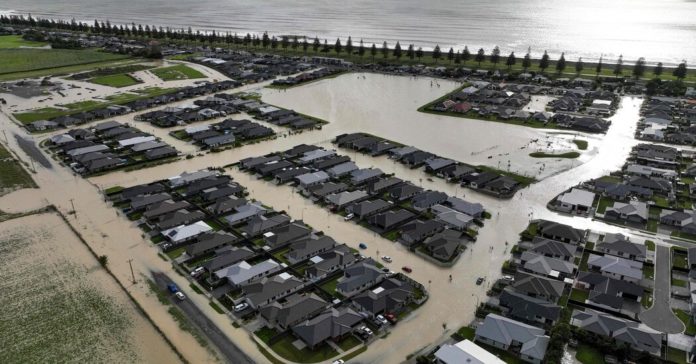In Hawke’s Bay, cows swam for their lives. In Northland, unremitting winds toppled electricity poles like matchsticks. And throughout New Zealand’s sodden North Island, people who had lost homes and livelihoods looked anxiously ahead to a slow, painful and expensive cleanup.
As of Thursday evening, five people had died and more than 3,500 were still unaccounted for days after Cyclone Gabrielle lashed the northern half of New Zealand, devastating vast swaths of land and displacing more than 10,000 people.
With communications still out in multiple New Zealand regions, the full extent of the damage from the storm — the worst in the country’s record — was unknown. The possibility of more bad weather loomed; the national weather agency, MetService, was warning of severe thunderstorms with possible hail in the North Island later Thursday night.
At least one economist has estimated that the recovery will cost billions, and Prime Minister Chris Hipkins said New Zealand would accept international aid. “This is a traumatic event,” Mr. Hipkins said at a news conference. “It’s a very big challenge to restore infrastructure as fast as we can, but we have to acknowledge that we are in for a bumpy ride.” Australia has offered to help.
On Tuesday, as the storm arrived, a national state of emergency was declared for only the third time in New Zealand’s history. That allowed Mr. Hipkins’s government to deploy more resources to move people out of harm’s way or send clean water and other supplies, including helicopters, two large ships and a C-130 Hercules transport plane.
Hawke’s Bay, on the east coast of the North Island — a region known as the “fruit bowl” of New Zealand — was among the areas hardest hit. Four of the five known deaths happened there; crops were ruined, and villages were covered in silt, according to reports in the local news media.
As floodwaters entered their homes, people fled to higher ground and evacuation centers in schools and marae, the meeting houses used by Maori, New Zealand’s Indigenous people.
In Te Karaka, a small town near the east coast, 500 people were forced to evacuate early Tuesday morning. “Everything happened so quickly,” one resident told a local TV station. “We all went up the hill, and then we just watched it unfold in front of us, and watched our town basically get downed.”
The Gisborne Herald, a local newspaper with a circulation of about 10,000, said on Twitter that its editorial staff had been “without any communications” until early Wednesday afternoon, before satellite internet became available and they were able to put an edition together. Some 22,000 issues were hand-delivered to residents so they would be informed about dwindling water supplies, Gisborne’s mayor, Rehette Stoltz, told Radio New Zealand.
Some New Zealanders took to social media to ask for updates from loved ones who had not been heard from. In one new Facebook group, which had thousands of new members, people shared updates and photographs, offered to do safety checks and volunteered spare bedrooms to those in need.
One viral video, posted to social media by a veterinarian clinic in Waipukurau, showed a flock of 23 cows swimming to safety across the Waipawa River after the floodwaters rose to the top of their necks. Kylie McIntyre, a dairy farmer, called to her cows from the riverbank: “Come on girls, come here.”
At the northernmost tip of the country, known as Northland, large areas were still underwater, said Jason Smith, a farmer and the former mayor of Kaipara, a rural area of about 27,000 people.
“There is still standing water, acres and acres of standing water now, kind of three days later, and you go, ‘Well, we’ve never had that before,’” he said. “The power poles and lines were basically ripped out of the ground by the force of the wind,” disconnecting the region from the national grid, he added.
Farmers in the region have especially struggled. Without power, dairy farmers were taking turns with emergency generators to milk their cows and avoid an animal health crisis. In Dargaville, where roughly 95 percent of all kumara, a New Zealand yam that is a staple of many diets, is grown, the flooding will have wiped out most of the crop for the year, Mr. Smith said.
“We are facing potentially a yield of 5 percent of what it normally is,” he added.
Mr. Hipkins said on Thursday that climate change would bring more such storms, and that New Zealand would have to ensure that its transportation, energy and communications systems were “as robust as possible.”
“We are going to see more of these types of events, and making sure that we are prepared for them is going to require a significant amount of time, energy and investment,” he said.
Earlier this week, in the first days of the storm, James Shaw, the co-leader of New Zealand’s Green Party, furiously chided other lawmakers for years of inaction on climate change, the effects of which he said were now becoming clear. “We cannot put our heads in the sand when the beach is flooding,” he said. “We must act now.”
Source : Nytimes











